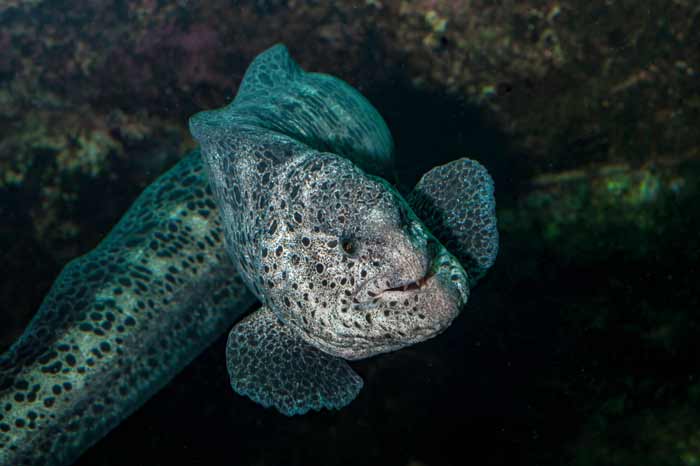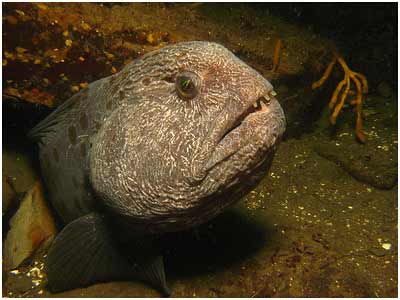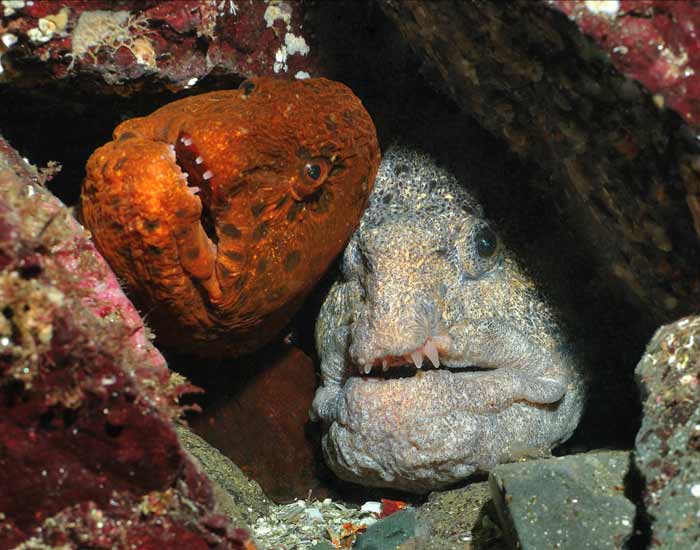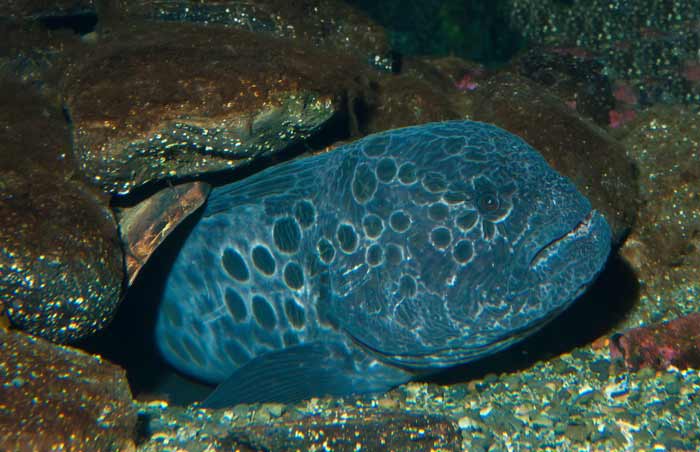The Wolf Eel, Anarrhichthys ocellatus, is a captivating marine species residing in the North Pacific Ocean. Despite its common name, this creature is not a true eel but is closely related to wolffish.
Renowned for its unique morphology and behavior, the Wolf Eel is a subject of interest in marine biology and ecology.
Taxonomy and Classification
| Kingdom | Animalia |
|---|---|
| Phylum | Chordata |
| Class | Actinopterygii |
| Order | Perciformes |
| Family | Anarhichadidae |
| Genus | Anarrhichthys |
| Species | A. ocellatus |
The Wolf Eel is the sole representative of the genus Anarrhichthys in the family Anarhichadidae. Its distinct features set it apart from true eels, aligning it more closely with wolffish.
Physical Description

The Wolf Eel can grow up to 8 feet in length and weigh around 40 pounds. It has a distinctive elongated body with a large head, resembling a wolf, which contributes to its common name. Unlike true eels, it lacks pelvic fins and has a dorsal fin that extends almost to the tail.
Adult Wolf Eels are generally grey, aiding in camouflage against the rocky ocean floor. Juveniles display a brighter orange color with dark spots. The skin of the Wolf Eel is smooth and covered in a layer of mucus.
Habitat and Distribution

The Wolf Eel inhabits the North Pacific Ocean, with a range extending from the Sea of Japan to Northern California.
This species thrives in rocky underwater landscapes, particularly favoring crevices and caves. These environments offer shelter from predators and abundant food sources. Wolf Eels are typically found at depths ranging from 10 to 225 meters.
Diet
The Wolf Eel’s diet primarily consists of crustaceans, mollusks, and sea urchins. Its powerful jaws and strong teeth are adapted for crushing the shells of these prey, an essential aspect of its feeding behavior.
Behavior

Wolf Eels are known for their monogamous pair bonds, a rare trait among fish. Pairs share dens and exhibit cooperative behaviors, such as hunting and den maintenance.
Wolf Eels are generally not aggressive towards humans. Divers often report friendly encounters with these creatures, highlighting their curious and non-threatening nature.
Reproduction
Wolf Eels have a unique reproductive process. Females lay eggs, which are then fertilized externally by the males. Male Wolf Eels are particularly involved in the reproductive process, guarding the eggs until they hatch. This level of paternal care is unusual among fish and underscores the unique nature of the species.
Conservation

The Wolf Eel is not currently listed as an endangered species. However, it faces environmental challenges, including habitat destruction and the impacts of climate change. Conservation efforts are focused on protecting their natural habitats and promoting sustainable practices to ensure their survival.
Facts about Wolf Eel
- Not a True Eel: Despite its name, the Wolf Eel is not a true eel. It belongs to the Anarhichadidae family, which is more closely related to wolffish.
- Unique Pair Bonding: Wolf Eels are known for their strong pair bonds. They often mate for life, a rare trait among fish, and are known to share the same den with their partner.
- Distinctive Appearance: Adult Wolf Eels have a distinctive look with a long, slender body and a large head. They can grow up to 8 feet in length.
- Diet: Their diet mainly consists of hard-shelled creatures like sea urchins, crabs, and mollusks. Their powerful jaws and strong teeth are perfect for crushing these shells.
- Habitat: Wolf Eels are typically found in the North Pacific Ocean, from Japan to California. They prefer rocky crevices and caves at depths ranging from shallow waters to 740 feet deep.
- Parental Care: Both male and female Wolf Eels show a high level of care for their offspring. Females lay up to 10,000 eggs, which the males then fertilize and help guard.
- Color Changes with Age: Juvenile Wolf Eels are bright orange with dark spots, which fade as they mature, turning into a more muted grey or brown.
- Gentle Giants: Despite their fearsome appearance, Wolf Eels are generally not aggressive towards humans and are known to be quite docile unless provoked.
- Long Lifespan: Wolf Eels can live up to 20 years in the wild, showcasing their resilience and adaptability in the marine environment.
- Important Ecological Role: By feeding on sea urchins and other shellfish, Wolf Eels help maintain the balance in their marine ecosystems, preventing overpopulation of these species.
Watch the Wolf Eel in Action
Conclusion
The Wolf Eel, Anarrhichthys ocellatus, is a remarkable species that adds to the diversity and intrigue of marine life. Its unique physical characteristics, social behaviors, and ecological role make it a fascinating subject for study and conservation.
Understanding the Wolf Eel’s life cycle and habitat needs is crucial for ensuring the health and sustainability of our oceanic environments.
FAQs
The Wolf Eel (Anarrhichthys ocellatus) is a species of marine fish belonging to the family Anarhichadidae. Despite its name, it is not a true eel but is closely related to wolffish.
Wolf Eels are found in the North Pacific Ocean, ranging from Northern Baja California to the Aleutian Islands, Alaska, and extending to the Seas of Japan.
Wolf Eels can grow up to 8 feet in length and weigh around 40 pounds, making them one of the larger fish within their family.
Their diet primarily consists of crustaceans, mollusks, and sea urchins. They have strong jaws and teeth adapted for crushing the shells of these prey.
Generally, Wolf Eels are not aggressive towards humans. Divers often report friendly and curious interactions with these creatures.
Reproduction involves external fertilization. Females lay eggs, which are then fertilized by the males. Male Wolf Eels play a significant role in protecting the eggs until they hatch.
The Wolf Eel is notable for its elongated body, strong jaws, and monogamous pair bonds, a rarity among fish. Its curious and non-threatening nature towards humans also makes it unique.